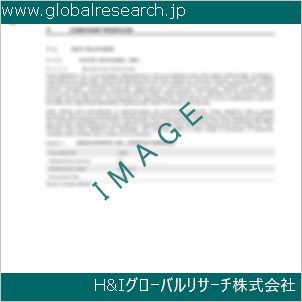Table of Contents
1 Industry Overview of Tridecylalcohol
1.1 Definition and Specifications of Tridecylalcohol
1.1.1 Definition of Tridecylalcohol
1.1.2 Specifications of Tridecylalcohol
1.2 Classification of Tridecylalcohol
1.3 Applications of Tridecylalcohol
1.3.1 Nuclear Application
1.3.2 Non-Nuclear Application
1.4 Industry Chain Structure of Tridecylalcohol
1.5 Industry Overview and Major Regions Status of Tridecylalcohol
1.5.1 Industry Overview of Tridecylalcohol
1.5.2 Global Major Regions Status of Tridecylalcohol
1.6 Industry Policy Analysis of Tridecylalcohol
1.7 Industry News Analysis of Tridecylalcohol
2 Manufacturing Cost Structure Analysis of Tridecylalcohol
2.1 Raw Material Suppliers and Price Analysis of Tridecylalcohol
2.2 Equipment Suppliers and Price Analysis of Tridecylalcohol
2.3 Labor Cost Analysis of Tridecylalcohol
2.4 Other Costs Analysis of Tridecylalcohol
2.5 Manufacturing Cost Structure Analysis of Tridecylalcohol
2.6 Manufacturing Process Analysis of Tridecylalcohol
3 Technical Data and Manufacturing Plants Analysis of Tridecylalcohol
3.1 Capacity and Commercial Production Date of Global Tridecylalcohol Major Manufacturers in 2023
3.2 Manufacturing Plants Distribution of Global Tridecylalcohol Major Manufacturers in 2023
3.3 R&D Status and Technology Source of Global Tridecylalcohol Major Manufacturers in 2023
3.4 Raw Materials Sources Analysis of Global Tridecylalcohol Major Manufacturers in 2023
4 Capacity, Production and Revenue Analysis of Tridecylalcohol by Regions, Types and Manufacturers
4.1 Global Capacity, Production and Revenue of Tridecylalcohol by Regions 2019-2024
4.2 Global and Major Regions Capacity, Production, Revenue and Growth Rate of Tridecylalcohol 2019-2024
4.3 Global Capacity, Production and Revenue of Tridecylalcohol by Types 2019-2024
4.4 Global Capacity, Production and Revenue of Tridecylalcohol by Manufacturers 2019-2024
5 Price, Cost, Gross and Gross Margin Analysis of Tridecylalcohol by Regions, Types and Manufacturers
5.1 Price, Cost, Gross and Gross Margin Analysis of Tridecylalcohol by Regions 2019-2024
5.2 Price, Cost, Gross and Gross Margin Analysis of Tridecylalcohol by Types 2019-2024
5.3 Price, Cost, Gross and Gross Margin Analysis of Tridecylalcohol by Manufacturers 2019-2024
6 Consumption Volume, Consumption Value and Sale Price Analysis of Tridecylalcohol by Regions, Types and Applications
6.1 Global Consumption Volume and Consumption Value of Tridecylalcohol by Regions 2019-2024
6.2 Global and Major Regions Consumption Volume, Consumption Value and Growth Rate of Tridecylalcohol 2019-2024
6.3 Global Consumption Volume and Consumption Value of Tridecylalcohol by Types 2019-2024
6.4 Global Consumption Volume and Consumption Value of Tridecylalcohol by Applications 2019-2024
6.5 Sale Price of Tridecylalcohol by Regions 2019-2024
6.6 Sale Price of Tridecylalcohol by Types 2019-2024
6.7 Sale Price of Tridecylalcohol by Applications 2019-2024
6.8 Market Share Analysis of Tridecylalcohol by Different Sale Price Levels
7 Supply, Import, Export and Consumption Analysis of Tridecylalcohol
7.1 Supply, Consumption and Gap of Tridecylalcohol 2019-2024
7.2 Global Capacity, Production, Price, Cost, Revenue, Supply, Import, Export and Consumption of Tridecylalcohol 2019-2024
7.3 USA Capacity, Production, Price, Cost, Revenue, Supply, Import, Export and Consumption of Tridecylalcohol 2019-2024
7.4 EU Capacity, Production, Price, Cost, Revenue, Supply, Import, Export and Consumption of Tridecylalcohol 2019-2024
7.5 China Capacity, Production, Price, Cost, Revenue, Supply, Import, Export and Consumption of Tridecylalcohol 2019-2024
7.6 Japan Capacity, Production, Price, Cost, Revenue, Supply, Import, Export and Consumption of Tridecylalcohol 2019-2024
8 Major Manufacturers Analysis of Tridecylalcohol
8.1 Manufacturer One
8.1.1 Company Profile
8.1.2 Product Picture and Specifications
8.1.2.1 Type I
8.1.2.2 Type II
8.1.2.3 Type III
8.1.3 Capacity, Production, Price, Cost, Gross and Revenue
8.1.4 Contact Information
8.2 Manufacturer Two
8.2.1 Company Profile
8.2.2 Product Picture and Specifications
8.2.2.1 Type I
8.2.2.2 Type II
8.2.2.3 Type III
8.2.3 Capacity, Production, Price, Cost, Gross and Revenue
8.2.4 Contact Information
8.3 Manufacturer Three
8.3.1 Company Profile
8.3.2 Product Picture and Specifications
8.3.2.1 Type I
8.3.2.2 Type II
8.3.2.3 Type III
8.3.3 Capacity, Production, Price, Cost, Gross and Revenue
8.3.4 Contact Information
8.4 Manufacturer Four
8.4.1 Company Profile
8.4.2 Product Picture and Specifications
8.4.2.1 Type I
8.4.2.2 Type II
8.4.2.3 Type III
8.4.3 Capacity, Production, Price, Cost, Gross and Revenue
8.4.4 Contact Information
8.5 Manufacturer Five
8.5.1 Company Profile
8.5.2 Product Picture and Specifications
8.5.2.1 Type I
8.5.2.2 Type II
8.5.2.3 Type III
8.5.3 Capacity, Production, Price, Cost, Gross and Revenue
8.5.4 Contact Information
…
9 Marketing Trader or Distributor Analysis of Tridecylalcohol
9.1 Marketing Channels Status of Tridecylalcohol
9.2 Traders or Distributors with Contact Information of Tridecylalcohol by Regions
9.3 Ex-work Price, Channel Price and End Buyer Price Analysis of Tridecylalcohol
9.4 Regional Import, Export and Trade Analysis of Tridecylalcohol
10 Industry Chain Analysis of Tridecylalcohol
10.1 Upstream Major Raw Materials Suppliers Analysis of Tridecylalcohol
10.1.1 Major Raw Materials Suppliers with Contact Information Analysis of Tridecylalcohol
10.1.2 Major Raw Materials Suppliers with Supply Volume Analysis of Tridecylalcohol by Regions
10.2 Upstream Major Equipment Suppliers Analysis of Tridecylalcohol
10.2.1 Major Equipment Suppliers with Contact Information Analysis of Tridecylalcohol
10.2.2 Major Equipment Suppliers with Product Pictures Analysis of Tridecylalcohol by Regions
10.3 Downstream Major Consumers Analysis of Tridecylalcohol
10.3.1 Major Consumers with Contact Information Analysis of Tridecylalcohol
10.3.2 Major Consumers with Consumption Volume Analysis of Tridecylalcohol by Regions
10.4 Supply Chain Relationship Analysis of Tridecylalcohol
11 Development Trend of Analysis of Tridecylalcohol
11.1 Capacity, Production and Revenue Forecast of Tridecylalcohol by Regions and Types
11.1.1 Global Capacity, Production and Revenue of Tridecylalcohol by Regions 2024-2029
11.1.2 Global and Major Regions Capacity, Production, Revenue and Growth Rate of Tridecylalcohol 2024-2029
11.1.3 Global Capacity, Production and Revenue of Tridecylalcohol by Types 2024-2029
11.2 Consumption Volume and Consumption Value Forecast of Tridecylalcohol by Regions, Types and Applications
11.2.1 Global Consumption Volume and Consumption Value of Tridecylalcohol by Regions 2024-2029
11.2.2 Global and Major Regions Consumption Volume, Consumption Value and Growth Rate of Tridecylalcohol 2024-2029
11.2.3 Global Consumption Volume and Consumption Value of Tridecylalcohol by Types 2024-2029
11.2.4 Global Consumption Volume and Consumption Value of Tridecylalcohol by Applications 2024-2029
11.3 Supply, Import, Export and Consumption Forecast of Tridecylalcohol
11.3.1 Supply, Consumption and Gap of Tridecylalcohol 2024-2029
11.3.2 Global Capacity, Production, Price, Cost, Revenue, Supply, Import, Export and Consumption of Tridecylalcohol 2024-2029
11.3.3 USA Capacity, Production, Price, Cost, Revenue, Supply, Import, Export and Consumption of Tridecylalcohol 2024-2029
11.3.4 EU Capacity, Production, Price, Cost, Revenue, Supply, Import, Export and Consumption of Tridecylalcohol 2024-2029
11.3.5 China Capacity, Production, Price, Cost, Revenue, Supply, Import, Export and Consumption of Tridecylalcohol 2024-2029
11.3.6 Japan Capacity, Production, Price, Cost, Revenue, Supply, Import, Export and Consumption of Tridecylalcohol 2024-2029
12 New Project Investment Feasibility Analysis of Tridecylalcohol
12.1 New Project SWOT Analysis of Tridecylalcohol
12.2 New Project Investment Feasibility Analysis of Tridecylalcohol
13 Conclusion of the Global Tridecylalcohol (CAS 112-70-9) Industry 2024 Market Research Report
| ※参考情報 トリデシルアルコールは、化学式C13H28Oを持つアルコールで、CAS番号は112-70-9として知られています。この化合物は、主に工業的な分野で広く利用されており、その用途は多岐にわたります。トリデシルアルコールは、脂肪族アルコールの一種で、長鎖の炭素構造が特徴です。これにより、親水性と疎水性の特性を持ち合わせており、さまざまな化学的性質を持ちます。 トリデシルアルコールの主な特徴として、まずその長い炭素鎖が挙げられます。この構造により、トリデシルアルコールは高い疎水性を持ち、油や脂肪に溶けやすい性質があります。さらに、低い揮発性の特性があり、常温下でも比較的安定しています。このため、トリデシルアルコールは、多くの油脂系製品の製造に利用されています。 トリデシルアルコールは、一般的にアルコールの中での炭素鎖の長さによって分類されます。短鎖アルコール(C1からC4)や中鎖アルコール(C5からC12)のアルコールに対して、トリデシルアルコールは長鎖アルコールに分類されます。これにより、特定の用途や製品において独自の特性を発揮します。たとえば、長鎖アルコールは乳化剤としての機能や、表面活性剤としての利用が広がっています。 用途としては、トリデシルアルコールは様々な製品の製造に使われます。特に、化粧品やパーソナルケア製品、洗剤、潤滑剤などに幅広く利用されます。化粧品業界では、乳液やクリーム、シャンプーなどに添加されることで、製品の滑らかさや質感を向上させる役割を果たしています。また、トリデシルアルコールは、乳化剤としても機能し、水と油を混ぜ合わせる助けとなります。 さらに、トリデシルアルコールは工業製品においても重要な役割を果たしています。特に、塗料やコーティング剤の製造において、一定の特性を持つトリデシルアルコールが使用されることがあります。この場合、塗料の粘度調整や分散剤として機能し、均一な塗布が可能になります。また、樹脂の合成においても、トリデシルアルコールは重要な原料として利用されることがあります。 トリデシルアルコールの関連技術としては、主に化学合成や精製のプロセスが挙げられます。トリデシルアルコールは、通常、天然資源からの分離や合成的な手法によって製造されます。原料としては植物油などが使われ、その後、化学反応を通じて精製されます。また、インダストリアルスケールでの生産においては、エコフレンドリーな技術や循環型のプロセスが求められることが多く、持続可能性に配慮した製造方法の模索が進められています。 また、トリデシルアルコールの安全性についても considerationが必要です。この物質は、適切に取り扱われれば比較的安全ですが、適用される規制や基準に従うことが重要です。化学物質に対するアレルギー反応を示すことがあるため、使用時には注意が必要であり、特に化粧品などの製品においては成分表示が求められます。 昨今、環境に優しい製品や成分が注目される中で、トリデシルアルコールもその利用において環境負荷の軽減が求められています。例えば、バイオベースの原材料からのトリデシルアルコールの生産が提案されており、これにより環境への影響を最小限に抑えることが可能となるでしょう。このようにして、トリデシルアルコールは今後もさまざまな分野での利用が期待される化合物であり、技術や製造方法の進化に伴い、その用途はさらに拡大する可能性があります。 結論として、トリデシルアルコールは、長鎖アルコールの一種として独自の特徴を持ち、多岐にわたる用途に利用されています。化粧品、工業製品、洗剤など、様々なプロダクトにおける重要な成分として位置づけられ、今後も持続可能な製造方法の模索と共に、その利用が進んでいくことが予想されます。トリデシルアルコールの可能性は今後の技術革新によってさらに広がることでしょう。 |
❖ 免責事項 ❖
http://www.globalresearch.jp/disclaimer

-gr.jpg)










